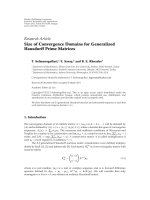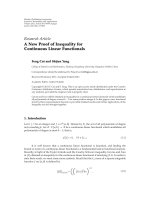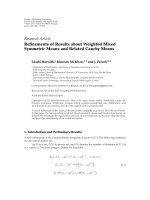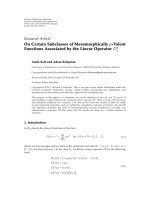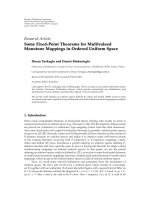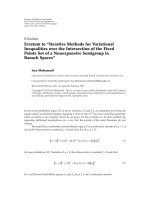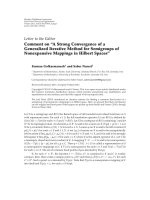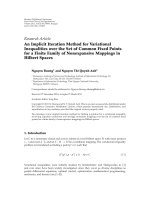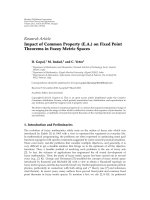Hindawi Publishing Corporation Journal of Inequalities and Applications Volume 2010, Article ID potx
Bạn đang xem bản rút gọn của tài liệu. Xem và tải ngay bản đầy đủ của tài liệu tại đây (489.1 KB, 10 trang )
Hindawi Publishing Corporation
Journal of Inequalities and Applications
Volume 2010, Article ID 591758, 10 pages
doi:10.1155/2010/591758
Research Article
Ordering Unicyclic Graphs in Terms of
Their Smaller Least Eigenvalues
Guang-Hui Xu
Department of Applied Mathematics, Zhejiang A&F University, Hangzhou 311300, China
Correspondence should be addressed to Guang-Hui Xu,
Received 15 July 2010; Accepted 2 December 2010
Academic Editor: J
´
ozef Bana
´
s
Copyright q 2010 Guang-Hui Xu. This is an open access article distributed under the Creative
Commons Attribution License, which permits unrestricted use, distribution, and reproduction in
any medium, provided the original work is properly cited.
Let G be a simple graph with n vertices, and let λ
n
G be the least eigenvalue of G. The connected
graphs in which the number of edges equals the number of vertices are called unicyclic graphs. In
this paper, the first five unicyclic graphs on order n in t erms o f their smaller least eigenvalues are
determined.
1. Introduction
Let G be a simple graph with n vertices, and let A be the 0, 1-adjacency matrix of G.We
call detλI − A the characteristic polynomial of G, denoted by PG; λ, or abbreviated PG.
Since A is symmetric, its eigenvalues λ
1
G,λ
2
G, ,λ
n
G are real, and we assume that
λ
1
G ≥ λ
2
G ≥···≥λ
n
G.Wecallλ
n
G the least eigenvalue of G. Up to now, some good
results on the least eigenvalues of simple graphs have been obtained.
1 In 1,letG be a simple graph with n vertices, G
/
K
n
,then
λ
n
G
≤ λ
n
K
1
n−1
. 1.1
The equality holds if and only if G
∼
K
1
n−1
,whereK
1
n−1
is the graph obtained from
K
n−1
by joining a vertex of K
n−1
with K
1
.
2 In 2–4,letG be a simple graph with n vertices, then
λ
n
G
≥−
n
2
n 1
2
.
1.2
2 Journal of Inequalities and Applications
The equality holds if and only if G
∼
K
n/2,n1/2
.
3 In 5,letG be a planar graph with n ≥ 3 vertices, then
λ
n
G
≥−
√
2n −4
.
1.3
The equality holds if and only if G
∼
K
2,n−2
.
4 In 6, the author surveyed the main results of the theory of graphs with least
eigenvalue −2 starting from late 1950s.
Connected graphs in which the number of edges equals the number of vertices are
called unicyclic graphs. Also, the least eigenvalues of unicyclic graphs have been studied in
thepastyears.Wenowgivesomerelatedworksonit.
1 In 7,letU
n
denote the set of unicyclic graphs on order n.Theauthors
characterized the unique graph with minimum least eigenvalue also in 8, 9
resp., the unique graph with maximum spread among all graphs in U
n
.
2 In 10,letG be a unicyclic graph with n vertices, and let G
∗
be the graph obtained
by joining each vertex of C
3
to a pendant vertex of P
k−1
,P
k
1
−1
,P
k
2
−1
, respectively,
where k ≥ k
1
≥ k
2
≥ 1, k − k
2
≤ 1, and k k
1
k
2
n.Then
λ
n
G
≤ λ
n
G
∗
. 1.4
The equality holds if and only if G
∼
G
∗
.
In this paper, the first five unicyclic graphs on order n in terms of their smaller least
eigenvalues are determined. The terminologies not defined here can be found in 11, 12.
2. Some Known Results on the S pectral Radii of Graphs
In this section, we will give some known results on the spectral radius of a forestry or an
unicyclic graph. They will be useful in the proofs of the following results.
Firstly, we write Sr, n −r − 21 ≤ r ≤ n −r − 2 denotes the tree of order n obtained
from the star K
1,n−r−1
by joining a pendant vertex of K
1,n−r−1
with rK
1
.
Lemma 2.1 see 13. Let F be a forestry with n vertices. F
/
K
1,n−1
, S1,n− 3, S2,n− 4.Then
λ
1
F
<λ
1
S
2,n− 4
<λ
1
S
1,n− 3
<λ
1
K
1,n−1
. 2.1
Now, we consider unicyclic graphs. For convenience, we write
U
n
G | G is an unicyclic graph with n vertices
,
U
n
k
G | G is an unicyclic graph in U
n
containing a circuit C
k
.
2.2
Also, we write C
n−k
k
denotes the unicyclic graph obtained from C
k
by joining a vertex
of C
k
with n − kK
1
,andC
k
n − k − 1, 1 denotes the unicyclic graph obtained from C
k
by
Journal of Inequalities and Applications 3
joining two adjacent vertices of C
k
with n − k −1K
1
and K
1
, respectively. Then we have the
following.
Lemma 2.2 see 14. λ
1
C
n−k
k
>λ
1
C
n−k−1
k1
, 3 ≤ k ≤ n − 1.
Lemma 2.3 see 15. Let G ∈U
n
k,G
/
C
n−k
k
, C
k
n −k − 1, 1,then
λ
1
G
<λ
1
C
k
n −k − 1, 1
<λ
1
C
n−k
k
. 2.3
Lemma 2.4 see 15. For n ≥ 8,onehas
λ
1
C
4
n −5, 1
>λ
1
C
n−5
5
. 2.4
3. The Least Eigenvalues of Unicyclic Graphs
Firstly, we give the following definitions of the order “ or ≺” between two graphs or two
sets of graphs.
Definition 3.1. Let G, H be two simple graphs on order n,andletG, H be two sets of simple
graphs on order n.
1 We say that “G is majorized or strictly majorized by H,” denoted by G H or
G ≺ H if λ
n
G ≤ λ
n
Hor λ
n
G <λ
n
H.
2 We say that “G is majorized or strictly majorized by H”, denoted by GHor
G≺H if λ
n
G ≤ λ
n
Hor λ
n
G <λ
n
H for each G ∈Gand H ∈H.
The following lemmas will be useful in the proofs of the main results.
Lemma 3.2 see 16. Let G be a simple graph with vertex set V G and u ∈ V G,then
P
G
λP
G −u
−
v
P
G − u − v
− 2
Z∈Cu
P
G − V
Z
,
3.1
where the first summation goes through all vertices v adjacent to u, and the second summation goes
through all circuits Z belonging to Cu, Cu denotes the set of all circuits containing the vertex u.
Lemma 3.3 see 12. Let V
1
be a subset of vertices of a graph G and |V G| n, |V
1
| k,then
λ
i
G
≥ λ
i
G −V
1
≥ λ
ik
G
,
1 ≤ i ≤ n − k
. 3.2
Lemma 3.4 see 2. Let G be a bipartite graph with n vertices, then
λ
i
G
−λ
n−i1
G
,
1 ≤ i ≤
n
2
.
3.3
Lemma 3.5 see 3. Let G be a simple graph with n vertices. Then there exist a spanning subgraph
G
of G such that G
is a bipartite graph and λ
n
G ≥ λ
n
G
.
4 Journal of Inequalities and Applications
Now, we consider the least eigenvalues of unicyclic graphs. For the graphs in U
n
3,
we have the following results.
Lemma 3.6. K
1,n−1
≺ C
n−3
3
≺ S1,n− 3, n ≥ 6.
Proof. By Lemma 3.2,wehave
P
C
n−3
3
λ
n−4
λ
4
− nλ
2
− 2λ
n −3
, 3.4
and by Lemma 3.5, there exist a spanning subgraph G
of C
n−3
3
such that G
is a bipartite
graph and λ
n
C
n−3
3
≥ λ
n
G
. Obviously, G
is a forestry. So, by Lemma 2.1,wehaveλ
n
G
≥
λ
n
K
1,n−1
.ButPC
n−3
3
; λ
n
K
1,n−1
/
0. Thus, λ
n
K
1,n−1
<λ
n
C
n−3
3
.
Also, by Lemma 3.2,wehave
P
S
1,n− 3
λ
n−4
λ
4
−
n − 1
λ
2
n − 3
. 3.5
Then P C
n−3
3
−PS1,n−3 −λ
n−3
λ 2. From the table of connected graphs on six
vertices in 17, we know that
λ
6
S
1, 3
< −2. 3.6
So, by Lemma 3.3,wehave
λ
n
S
1,n− 3
≤ λ
6
S
1, 3
< −2. 3.7
Thus, PC
n−3
3
; λ
n
S1,n− 3 −1
n−1
q
n
,whereq
n
> 0. Also, by Lemma 3.3,wehave
λ
n−1
C
n−3
3
≥ λ
n−1
K
1,n−2
≥ λ
n
S
1,n− 3
. 3.8
So, λ
n
C
n−3
3
<λ
n
S1,n− 3. Hence the result holds.
Lemma 3.7. For n ≥ 9,onehas
S
1,n− 3
≺ C
n−4
3
1
≺ C
3
n − 4, 1
≺ S
2,n− 4
,
3.9
where C
n−4
3
1 denotes the graph obtained from C
n−4
3
by joining a pendant vertex of C
n−4
3
with K
1
.
Proof. By Lemma 3.2,wehave
P
C
n−4
3
1
λ
n−6
λ
2
− 1
λ
4
−
n − 1
λ
2
− 2λ
n − 5
,
P
S
1,n− 3
λ
n−4
λ
4
−
n − 1
λ
2
n − 3
.
3.10
Journal of Inequalities and Applications 5
And by Lemma 3.5, there exist a spanning subgraph G
of C
n−4
3
1 such that G
is a bipartite
graph and λ
n
C
n−4
3
1 ≥ λ
n
G
. Obviously, G
is a forestry and G
/
K
1,n−1
for n ≥ 5. So, by
Lemma 3.6,wehaveλ
n
G
≥ λ
n
S1,n− 3.ButPC
n−4
3
1; λ
n
S1,n− 3
/
0. Thus
S
1,n− 3
≺ C
n−4
3
1
.
3.11
Also, by Lemma 3.2,wehave
P
C
3
n −4, 1
λ
n−4
λ
4
− nλ
2
− 2λ
2n −7
, 3.12
So
P
C
n−4
3
1
− P
C
3
n − 4, 1
λ
n−6
λ
2
2λ −
n − 5
. 3.13
The least root of λ
2
2λ − n − 50is−1 −
√
n − 4. Let f
n
λλ
4
− nλ
2
− 2λ 2n − 7,then
we have
f
n
−1 −
√
n − 4
9n −12 2
n − 5
√
n − 4 > 0,
n ≥ 5
. 3.14
Moreover, by Lemma 3.3,weknow
λ
n−1
C
3
n − 4, 1
≥ λ
n−1
K
1,n−3
∪ K
1
−
√
n − 3 > −1 −
√
n −4,
n ≥ 5
.
3.15
So,
λ
n
C
3
n − 4, 1
> −1 −
√
n − 4
.
3.16
Thus,
P
C
n−4
3
1
; λ
n
C
3
n − 4, 1
−1
n1
q
n
,q
n
> 0. 3.17
Then, C
n−4
3
1 ≺ C
3
n − 4, 1.
By Lemma 3.2,wehave
P
S
2,n− 4
λ
n−4
λ
4
−
n −1
λ
2
2
n − 4
, 3.18
and
λ
n
S
2,n− 4
−
1
2
n −1
n −5
2
8
1/2
.
3.19
6 Journal of Inequalities and Applications
So,
P
C
3
n − 4, 1
− P
S
2,n− 4
−λ
n−4
λ
2
2λ − 1
. 3.20
Thus, when n ≥ 9, it is not difficult to know that
P
C
3
n −4, 1
; λ
n
S
2,n− 4
−1
n1
q
n
,q
n
> 0,
3.21
then C
3
n −4, 1 ≺ S2,n− 4.
Lemma 3.8. Let G ∈U
n
3, G
/
C
n−3
3
, C
n−4
3
1, C
3
n − 4, 1,then,forn ≥ 6,onehas
S
2,n− 4
G. 3.22
Proof. Let G
/
C
n−3
3
, C
n−4
3
1, C
3
n−4, 1. Then, by Lemma 3.5, there exist a spanning subgraph
G
such that G
is a bipartite graph and λ
n
G ≥ λ
n
G
. Obviously, G
is a forestry and
G
/
K
1,n−1
,S1,n− 3 for n ≥ 6. So, by Lemma 2.1,wehave
λ
n
G
≥ λ
n
S
2,n− 4
,
n ≥ 6
. 3.23
Thus
S
2,n− 4
G,
n ≥ 6
. 3.24
Now, we consider the graphs in U
n
4, we have the following results.
Lemma 3.9. K
1,n−1
≺ C
n−4
4
≺ S1,n− 3, n ≥ 4.
Proof. By Lemma 3.2,wehave
P
S
1,n− 3
λ
n−4
λ
4
−
n − 1
λ
2
n − 3
,
P
C
n−4
4
λ
n−4
λ
4
− nλ
2
2
n −4
.
3.25
We can easily to know that
λ
n
C
n−4
4
−
1
2
n
n −4
2
16
1/2
,
λ
n
S
1,n− 3
−
1
2
n −1
n −3
2
4
1/2
.
3.26
Journal of Inequalities and Applications 7
Moreover, λ
n
K
1,n−1
−
√
n − 1. So,
λ
n
K
1,n−1
<λ
n
C
n−4
4
<λ
n
S
1,n− 3
,
n ≥ 4
. 3.27
And then,
K
1,n−1
≺ C
n−4
4
≺ S
1,n− 3
,
n ≥ 4
.
3.28
Lemma 3.10. For n ≥ 9,onehas
S
1,n− 3
≺ C
4
n −5, 1
≺ S
2,n− 4
. 3.29
Proof. By Lemma 3.2,weget
P
C
4
n −5, 1
λ
n−6
λ
6
− nλ
4
3n −13
λ
2
−
n − 5
,
P
S
1,n− 3
λ
n−6
λ
6
−
n − 1
λ
4
n − 3
λ
2
.
3.30
So,
P
C
4
n −5, 1
− P
S
1,n− 3
λ
n−6
−λ
4
2
n − 5
λ
2
−
n −5
. 3.31
Since
λ
n
S
1,n− 3
−
1
2
n −1
n −3
2
4
1/2
.
3.32
So,
P
C
4
n − 5, 1
; λ
n
S
1,n− 3
1
2
λ
n
S
1,n− 3
n−6
n −5
2
n − 9
n − 3
2
4 − 12
.
3.33
It is not difficult to know that n − 5
2
n − 9
n − 3
2
4 − 12 > 0forn ≥ 9. Thus,
P
C
4
n −5, 1
; λ
n
S
1,n− 3
−1
n
q
n
,q
n
> 0. 3.34
Furthermore, by Lemma 3.3,wehave
λ
n
S
1,n− 3
≤ λ
n−1
S
1,n− 4
≤ λ
n−1
C
4
n − 5, 1
. 3.35
8 Journal of Inequalities and Applications
So λ
n
C
4
n −5, 1 >λ
n
S1,n− 3 for n ≥ 9. It means that S1,n− 3 ≺ C
4
n −5, 1 for n ≥ 9.
Since S2,n−4 is a spanning subgraph of C
4
n−5, 1.Soλ
n
C
4
n−5, 1 <λ
n
S2,n−4
for n ≥ 6. It means that C
4
n −5, 1 ≺ S2,n− 4 for n ≥ 6.
Lemma 3.11. Let G ∈U
n
k,k ≥ 4, G
/
C
n−4
4
,C
4
n −5, 1.ThenC
4
n −5, 1 ≺ G.
Proof. When G ∈U
n
4, G
/
C
n−4
4
, C
4
n −5, 1,byLemma 2.3,wehave
λ
1
G
<λ
1
C
4
n − 5, 1
. 3.36
Then, by Lemma 2.2,wehave
λ
n
G
>λ
n
C
4
n − 5, 1
. 3.37
When G ∈U
n
k,k ≥ 5, by Lemmas 2.2 and 2.4,wehave
λ
1
G
≤ λ
1
C
n−5
5
<λ
1
C
4
n −5, 1
. 3.38
So,
λ
n
G
≥−λ
1
G
>λ
n
C
4
n − 5, 1
. 3.39
Thus the result holds.
Lemma 3.12. C
n−4
4
≺ C
n−3
3
for 4 ≤ n ≤ 11 and C
n−3
3
≺ C
n−4
4
for n>11.
Proof. By the proof of Lemma 3.6,wehave
P
C
n−3
3
λ
n−4
λ
4
− nλ
2
− 2λ
n −3
,
λ
n
C
n−4
4
−
1
2
n
n −4
2
16
1/2
.
3.40
So
P
C
n−3
3
; λ
n
C
n−4
4
λ
n
C
n−4
4
n−4
−n 5
2
n
n − 4
2
16
1/2
. 3.41
Let f
n
−n 5 2n
n − 4
2
16
1/2
.Itisnotdifficult to know that f
n
> 0for4≤ n ≤ 11
and f
n
< 0forn>11. Furthermore, by Lemma 3.3,wehave
λ
n
C
n−4
4
≤ λ
n−1
K
1,n−2
≤ λ
n−1
C
n−3
3
. 3.42
Journal of Inequalities and Applications 9
So, by the sign of PC
n−3
3
; λ
n
C
n−4
4
, we know that λ
n
C
n−3
3
>λ
n
C
n−4
4
for 4 ≤ n ≤ 11 and
λ
n
C
n−3
3
<λ
n
C
n−4
4
for n>11. Thus the result holds.
Lemma 3.13. C
3
n − 4, 1 ≺ C
4
n − 5, 1 for n ≥ 6.
Proof. By the proofs of Lemmas 3.7 and 3.10,wehave
P
C
3
n − 4, 1
λ
n−4
λ
4
− nλ
2
− 2λ
2n −7
,
P
C
4
n −5, 1
λ
n−6
λ
6
− nλ
4
3n −13
λ
2
−
n − 5
,
3.43
so
P
C
3
n − 4, 1
− P
C
4
n −5, 1
−λ
n−6
2λ
3
n −6
λ
2
−
n −5
, 3.44
since
λ
n
C
4
n − 5, 1
>λ
n
K
1,n−1
−
√
n − 1
n ≥ 8
.
3.45
And by Lemma 3.3, we know that
λ
n
C
4
n − 5, 1
≤ λ
n−2
K
1,n−3
−
√
n − 3
.
3.46
Now, let
f
n
λ
2λ
3
n −6
λ
2
−
n −5
λ
2
2λ
n −6
−
n − 5
,
3.47
then
f
n
λ
n
C
4
n − 5, 1
>
n − 3
−2
√
n − 1
n − 6
−
n − 5
. 3.48
It is easy to know that f
n
λ
n
C
4
n −5, 1 > 0forn ≥ 15. Thus,
P
C
3
n − 4, 1
; λ
n
C
4
n −5, 1
−1
n1
q
n
,q
n
> 0.
3.49
Hence C
3
n − 4, 1 ≺ C
4
n − 5, 1 for n ≥ 15.
When 6 ≤ n ≤ 14, by immediate calculation, we know the result holds too. This
completes the proof.
10 Journal of Inequalities and Applications
4. Main Results
Now, we give the main result of this paper.
Theorem 4.1. Let G ∈U
n
, G
/
C
n−3
3
,C
n−4
4
,C
n−4
3
1,C
3
n −4, 1,C
4
n −5, 1,then
1 C
n−4
4
≺ C
n−3
3
≺ C
n−4
3
1 ≺ C
3
n −4, 1 ≺ C
4
n −5, 1 ≺ G for 9 ≤ n ≤ 11;
2 C
n−3
3
≺ C
n−4
4
≺ C
n−4
3
1 ≺ C
3
n −4, 1 ≺ C
4
n −5, 1 ≺ G for n>11.
Proof. By the Lemmas 3.6–3.13, we know that the result holds.
Acknowledgment
This work was supported by Zhejiang Provincial Natural Science Foundation of China no.
Y7080364.
References
1 Y. Hong, “On the least eigenvalue of a graph,” Systems Science and Mathematical Sciences,vol.6,no.3,
pp. 269–272, 1993.
2 G. Constantine, “Lower bounds on the spectra of symmetric matrices with nonnegative entries,”
Linear Algebra and Its Applications, vol. 65, pp. 171–178, 1985.
3 Y. Hong, “Bounds of eigenvalues of a graph,” Acta Mathematicae Applicatae Sinica,vol.4,no.2,pp.
165–168, 1988.
4 D. L. Powers, “Graph partitioning by eigenvectors,” Linear Algebra and Its Applications, vol. 101, pp.
121–133, 1988.
5 Y. Hong and J L. Shu, “Sharp lower bounds of the least eigenvalue of planar graphs,” Linear Algebra
and Its Applications, vol. 296, no. 1–3, pp. 227–232, 1999.
6 D. M. Cvetkovi
´
c, “Graphs with least eigenvalue −2; a historical survey and recent developments in
maximal exceptional graphs,” Linear Algebra and Its Applications, vol. 356, pp. 189–210, 2002.
7 Y Z. Fan, Y. Wang, and Y B. Gao, “Minimizing the least eigenvalues of unicyclic graphs with
application to spectral spread,” Linear Algebra and Its Applications, vol. 429, no. 2-3, pp. 577–588, 2008.
8 Y R Wu and J L Shu, “The spread of the unicyclic graphs,” European Journal of Combinatorics, vol. 31,
no. 1, pp. 411–418, 2010.
9 G H. Xu, Q F. Xu, and S K. Wang, “A sharp lower bound on the least eigenvalue of unicyclic
graphs,” Journal of Ningbo University (NSEE), vol. 16, no. 3 , pp. 225–227, 2003 Chinese.
10 G H. Xu, “Upper bound on the least eigenvalue of unicyclic graphs,” Journal of Zhejiang Forestry
University, no. 3, pp. 304–309, 1998 Chinese.
11 B. Bollob
´
as, Modern Graph Theory, vol. 184 of Graduate Texts in Mathematics, Springer, New York, NY,
USA, 1998.
12 D. M. Cvetkovi
´
c, M. Doob, and H. Sachs, Spectra of Graphs,vol.87ofPure and Applied Mathematics
,
Academic Press, New York, NY, USA, 2nd edition, 1980.
13 M. Hofmeister, “On the two largest eigenvalues of trees,” Linear Algebra and Its Applications, vol. 260,
pp. 43–59, 1997.
14 Y. Hong, “Bounds on the spectra of unicyclic graphs,” Journal of East China Normal University,no.1,
pp. 31–34, 1986 Chinese.
15 S. G. Guo, “First six unicyclic graphs of order n with larger spectral radius,” Applied Mathematics A
Journal of Chinese Universities, vol. 18, no. 4, pp. 480–486, 2003 Chinese.
16 A. J. Schwenk, “Computing the characteristic polynomial of a graph,” in Graphs and Combinatorics
(Proc. Capital Conf., George Washington Univ., W ashington, D.C., 1973), vol. 406 of Lecture Notes in Math.,
pp. 153–172, Springer, Berlin, Germany, 1974.
17 D. M. Cvetkovi
´
candM.Petri
´
c, “A table of connected graphs on six vertices,” Discrete Mathematics,
vol. 50, no. 1, pp. 37–49, 1984.
